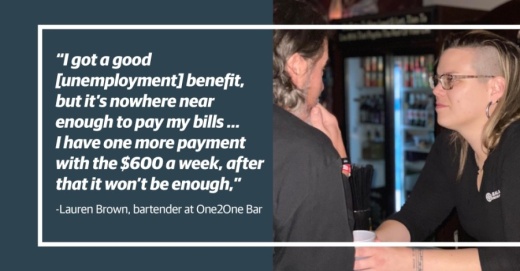Brown said she was able to sign up for unemployment the next day. She receives $458 a week in unemployment insurance from the Texas Workforce Commission and, thanks to a new federal benefit that went into effect March 27, an additional $600 temporary stipend per week.
Federal lawmakers are meeting in Washington to discuss a potential new coronavirus relief package, which could include an extension of the unemployment add-on. In Texas, the additional benefit runs out July 25. If it goes away, Brown said, she does not think she can hang on too much longer.
"I got a good benefit, but it's nowhere near enough to pay my bills," she said. "I have one more payment with the $600 a week; after that, it won't be enough."
Brown's husband works full time, and she said his income is enough to help them keep up with health insurance and the mortgage payments. But the couple has a 3-year-old child to think about, and if she loses the $600 weekly benefit, Brown said she cannot hang on too long waiting for One2One to reopen.
"I can survive through August ... if I use up all my savings," she said. "If we aren't open by September, I have to go somewhere else."
Sowmya Somanath, a musician who lives in Travis Heights, said the federal benefit has helped her tremendously in a time when she is unable to make any income through live performances.
"It's going to be a tough blow losing that assistance, as I will be relying on savings and my partner's income," Somanath wrote in an email. "Currently, I'm trying to ramp up my income through online music lessons." TWC data shows that many Austin residents who are out of work are making the same calculations as Brown and Somanath.
While unemployment numbers have rebounded since bottoming out in April, there are still 90,887 Austin-area residents receiving UI benefits as of July 17, an unemployment rate of 7.5%—significantly lower than the 11.9% nationwide rate, but about three times higher than it was before the pandemic.
The TWC said the average Texan receiving an unemployment benefit was making about $671 a week before they were laid off. Before July 25, they were making $949 a week in UI benefits. Unless the federal government extends those benefits, that average weekly payment will drop to $349 a week after July 25, which represents just over half the wages the average worker was previously earning.
TWC spokesperson Cisco Gamez said the organization will do everything it can to help unemployed Texans after the benefit expires, from posting job information to offering workforce training. He also said the benefits were never intended as a permanent solution.
"Unemployment in general is not supposed to replace work; it's just supposed to help," Gamez said.
Benefits from the TWC ranged from $69 to $521 a week before the additional benefit was put into place, according to Gamez, and anyone who collects even $1 in state unemployment is eligible for the additional federal funding. However, losing the $600 would have an outsize impact on those who were making less before they were fired or laid off.
According to U.S. Census data, the median income in Austin as of 2018 was $67,462 a year. If a median income earner were to be laid off, he or she would receive the maximum state benefit possible: $521 a week, or $1,121 a week with the additional benefit. If the benefit were to expire, that individual would see their weekly stipend cut by 53.5%.
On the other hand, someone working full time and making the minimum wage in Texas, $7.25 an hour, would see their benefit cut by nearly 80%. That individual would be receiving $151 in weekly benefits from TWC, or $751 in total with the federal add-on.
Workforce Solutions Capital Area, a local nonprofit organization that supports Austin workers, said about 75% of unemployed residents previously earned less than $50,000 a year when they were working.
Workforce Solutions CEO Tamara Atkinson said many workers likely will not feel safe returning to work for a while, or they may be holding out until the business where they work reopens. She said Workforce Solutions is doing everything it can for those workers in the short term and is also keeping an eye on long term goals.
With residents home by choice or by circumstance, Atkinson said the community has a "one-shot" chance to make sure everyone can be a part of the city's future success.
"I think it is really important to note that as a region, we were struggling with inequality before COVID. We had pockets of our community that were not sharing in the full economic prosperity Austin had been enjoying for so long," Atkinson said.
Brown has considered entering programs to acquire new skills for a career change, but she said she likes being a bartender—the interactions with her client and the tight-knit staff at One2One—and that she does not have a desire to do anything else.
"I still want to do this. I still would like to open my own bar someday," Brown said. "But it’s definitely changed my idea on the stability of the industry."





